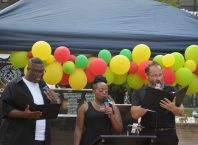The 1950s-era courthouse in downtown Tyler outlived its usefulness long ago, but the final decision on whether to replace it should be decided by taxpayers, Smith County Judge Nathaniel Moran said Monday.
“The role of the commissioners is to manage and maintain the facility,” he said. “Citizens should have the opportunity to self-determine the funding of their courthouse.”
They may get the chance if commissioners support calling a November referendum asking voters to approve up to $179 million in bonds to fund the project.
The vote is scheduled for Aug. 9.
Moran spent nearly two hours explaining a planning process spanning more than two decades that included input from consultants, community stockholders, county officials and citizens.

As it stands now, the proposal contains two options: issuing $160 million in bonds to fund construction of a seven-story courthouse; or issuing $179 million in bonds to build a courthouse and a parking garage.
If approved, construction could begin sometime in late 2023 or early 2024 and is expected to take 27 months to complete.
Courthouse history
The current mid-century modern style courthouse opened in 1955, replacing a building that had served the county from 1910 to 1954. At the time it opened, the county maintained only two trial courtrooms and the building layout did not consider future growth, Moran said.
Although county officials eventually managed to squeeze in two more district courtrooms and three county courts, the building no longer provides enough space to operate business in a safe and efficient manner, he said.
The county’s fifth district court is expected to open in January and could only be accommodated by moving another courtroom to the county’s annex building across the street.
“It is by far the longest facility we have used in Smith County,” Moran said.
Overcrowding, he said, creates serious issues because jurors often walk in the same hallways that victims, witnesses, judges, attorneys and families of defendants must also use.
Jury deliberation rooms and restrooms also are inadequate.
Michael Hurley told commissioners Monday he recently served on a jury that deliberated in a small room with no air conditioning and dusty old fans.
“We had a very serious conversation in a very uncomfortable room,” he said.
Commissioners also heard a story about how new chairs for a jury room had to be replaced because not all 12 could fit into the room.
New courthouse proposal
Moran said county officials looked at five potential sites for a new courthouse and decided upon an area just east of the current building. Moran said the county already has purchased five of the 11 properties needed for the project.
He described the new building’s design as a “throwback” to the 1910 domed courthouse and includes three floors just for courts, one floor for the district clerk’s office and jury assembly, one floor for the county clerk’s office, one floor for the district attorney’s office and a smaller top floor to accommodate the 12th Court of Appeals, which currently convenes in the Cotton Belt Building on Front Street.
The design includes secure underground parking for judges. Judges currently park around the perimeter of the courthouse.
Most importantly, Moran said the new design offers three separate elevator systems and separate corridors to keep members of the public, in-custody inmates and judges and staff from sharing the same space. Jurors will have larger deliberating rooms with their own restrooms, and there is space designated for future growth, he added.
The courthouse’s exterior also is expected to incorporate the words “Justice, Humility, Mercy.”
“There are such important things that go on in the courthouse,” Moran said. “Our facility should reflect the very nature of the character and importance of those activities inside the courthouse.”
The overall design, he said, reflects “an air of reverence and respect.”
Financial aspect
Moran said cost estimates in the past have continued to grow and likely is “only going to cost more next year.” In 1999, a task force learned building a new courthouse would cost $37 million with another $7.2 million for a parking garage, he said.
Previous commissioner courts could have issued certificates of obligation but decided it was important to let the voters decide, he said.
If approved, taxpayers can expect to see a tax increase of about 3.67 cents, which equates to about $73.40 more per year for a home valued at $200,000, according to county records.
Of the 15 people who expressed their opinion to the court on Monday, only one opposed calling the bond election now. Although many of those speakers expressed concerns for losing some of Tyler’s historic buildings to make room for the new courthouse, they said they realize the loss is necessary to create a safer and more efficient environment for county business.
“The best time to do it (build a new courthouse) was 20 years ago. The second-best time is now,” John Landis told commissioners.
Love what you're seeing in our posts? Help power our local, nonprofit journalism platform — from in-depth reads, to freelance training, to COVID Stories videos, to intimate portraits of East Texans through storytelling.
Our readers have told us they want to better understand this place we all call home, from Tyler's north-south divide to our city's changing demographics. What systemic issues need attention? What are are greatest concerns and hopes? What matters most to Tylerites and East Texans?
Help us create more informed, more connected, more engaged Tyler. Help us continue providing no paywall, free access posts. Become a member today. Your $15/month contribution drives our work.







